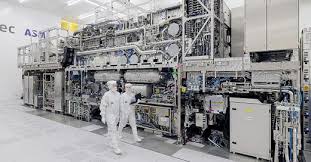Introduction: The Invisible Giant
In an era where technology evolves at breakneck speed, few companies wield as much influence over global innovation as ASML. This Dutch firm, which specializes in photolithography systems for the semiconductor industry, is a pivotal player in a complex web of supply chains that underpins modern electronics. As manufacturers race to develop smaller, faster, and more efficient chips, ASML’s cutting-edge machines are at the heart of this race.
The Context: Why ASML Matters
The semiconductor industry has faced unprecedented challenges in recent years—rising demand, supply chain disruptions, and geopolitical tensions have all contributed to a semiconductor shortage that has impacted everything from consumer electronics to automotive production. As the world becomes increasingly reliant on technology, the importance of efficient chip manufacturing cannot be overstated. ASML’s advances in extreme ultraviolet (EUV) lithography technology have enabled semiconductor companies like TSMC and Samsung to produce chips at a scale and complexity previously deemed impossible.
Technological Innovations
ASML’s EUV machines utilize advanced optics to manipulate light at unprecedented wavelengths, allowing manufacturers to etch finer patterns onto silicon wafers. This innovation is particularly crucial for the production of advanced chips that power everything from smartphones to artificial intelligence applications. “ASML is effectively rewriting the rules of semiconductor manufacturing with its revolutionary technology,” explains Dr. Jane Vos, a semiconductor analyst at the Institute of Technology Policy. “Their equipment is not just tools; they’re the keys that unlock the future of processing power.”
The Economic Landscape
With rising demand for innovative technology, ASML’s market position has never been more robust. In its recent quarterly report, the company announced record revenues, and its stock remains a favorite among investors looking for a stake in the technology sector. As of October 2023, ASML reported a stunning 72% increase in net profit compared to the same period last year, indicating a booming market amidst challenges. Social media sentiment reflects a growing confidence in ASML’s potential, with hashtags like #FutureOfSemiconductors gaining traction across platforms.
Challenges Ahead
However, this success is not without its hurdles. The company finds itself in the crosshairs of U.S.-China trade tensions, with the Biden administration imposing export controls on semiconductor technology to China. As ASML navigates these geopolitical waters, its ability to maintain its competitive edge while complying with international regulations will be vital. Industry insiders suggest that a bifurcation of the global semiconductor market could emerge, where countries align with either the U.S. or China, potentially impacting ASML’s customer base.
The Road Ahead
As ASML continues to innovate and respond to market demands, its role in shaping the semiconductor landscape appears secure. The company is investing heavily in research and development to expand its portfolio beyond lithography, venturing into advanced packaging and materials science. This strategic foresight could position ASML as a more integrated player in the broader semiconductor ecosystem.
Conclusion: A Beacon of Innovation
ASML stands at a crossroads—capitalizing on its market leadership while maneuvering through complex global dynamics. As nations grapple with securing their semiconductor supply chains, ASML’s technology will likely remain a significant determinant of who leads the technological frontier. In a world increasingly defined by digital capabilities, the spotlight on ASML will only grow brighter.
